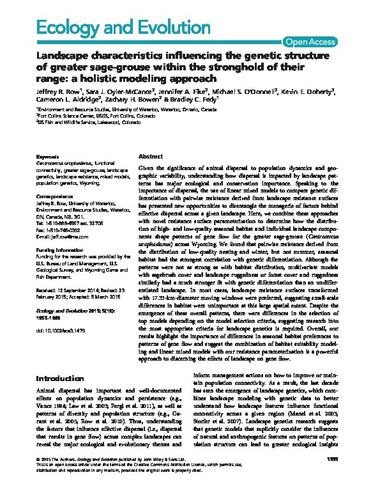| dc.contributor.author | Row, Jeffrey R. | |
| dc.contributor.author | Oyler-McCance, Sara J. | |
| dc.contributor.author | Fike, Jennifer A. | |
| dc.contributor.author | O'Donnell, Michael S. | |
| dc.contributor.author | Doherty, Kevin E. | |
| dc.contributor.author | Aldridge, Cameron L. | |
| dc.contributor.author | Bowen, Zachary H. | |
| dc.contributor.author | Fedy, Bradley C. | |
| dc.date.accessioned | 2018-04-18 13:49:01 (GMT) | |
| dc.date.available | 2018-04-18 13:49:01 (GMT) | |
| dc.date.issued | 2015-05-01 | |
| dc.identifier.uri | http://dx.doi.org/10.1002/ece3.1479 | |
| dc.identifier.uri | http://hdl.handle.net/10012/13099 | |
| dc.description.abstract | Given the significance of animal dispersal to population dynamics and geographic variability, understanding how dispersal is impacted by landscape patterns has major ecological and conservation importance. Speaking to the importance of dispersal, the use of linear mixed models to compare genetic differentiation with pairwise resistance derived from landscape resistance surfaces has presented new opportunities to disentangle the menagerie of factors behind effective dispersal across a given landscape. Here, we combine these approaches with novel resistance surface parameterization to determine how the distribution of high- and low-quality seasonal habitat and individual landscape components shape patterns of gene flow for the greater sage-grouse (Centrocercus urophasianus) across Wyoming. We found that pairwise resistance derived from the distribution of low-quality nesting and winter, but not summer, seasonal habitat had the strongest correlation with genetic differentiation. Although the patterns were not as strong as with habitat distribution, multivariate models with sagebrush cover and landscape ruggedness or forest cover and ruggedness similarly had a much stronger fit with genetic differentiation than an undifferentiated landscape. In most cases, landscape resistance surfaces transformed with 17.33-km-diameter moving windows were preferred, suggesting small-scale differences in habitat were unimportant at this large spatial extent. Despite the emergence of these overall patterns, there were differences in the selection of top models depending on the model selection criteria, suggesting research into the most appropriate criteria for landscape genetics is required. Overall, our results highlight the importance of differences in seasonal habitat preferences to patterns of gene flow and suggest the combination of habitat suitability modeling and linear mixed models with our resistance parameterization is a powerful approach to discerning the effects of landscape on gene flow. | en |
| dc.description.sponsorship | U.S. Bureau of Land Management | en |
| dc.description.sponsorship | U.S. Geological Survey | en |
| dc.description.sponsorship | Wyoming Game and Fish Department | en |
| dc.language.iso | en | en |
| dc.publisher | Wiley | en |
| dc.rights | Attribution 4.0 International | * |
| dc.rights.uri | https://creativecommons.org/licenses/by/4.0/ | * |
| dc.subject | Centrocercus urophasianus | en |
| dc.subject | functional connectivity | en |
| dc.subject | greater sage-grouse | en |
| dc.subject | landscape genetics | en |
| dc.subject | landscape resistance | en |
| dc.subject | mixed models | en |
| dc.subject | population genetics | en |
| dc.subject | Wyoming | en |
| dc.subject.lcsh | sage grouse | en |
| dc.subject.lcsh | population genetics | en |
| dc.subject.lcsh | Wyoming | en |
| dc.title | Landscape characteristics influencing the genetic structure of greater sage-grouse within the stronghold of their range: a holistic modeling approach | en |
| dc.type | Article | en |
| dcterms.bibliographicCitation | Row, J. R., Oyler-McCance, S. J., Fike, J. A., O’Donnell, M. S., Doherty, K. E., Aldridge, C. L., … Fedy, B. C. (2015). Landscape characteristics influencing the genetic structure of greater sage-grouse within the stronghold of their range: a holistic modeling approach. Ecology and Evolution, 5(10), 1955–1969. https://doi.org/10.1002/ece3.1479 | en |
| uws.contributor.affiliation1 | Faculty of Environment | en |
| uws.contributor.affiliation2 | School of Environment, Resources and Sustainability | en |
| uws.typeOfResource | Text | en |
| uws.typeOfResource | Text | en |
| uws.peerReviewStatus | Reviewed | en |
| uws.scholarLevel | Faculty | en |


